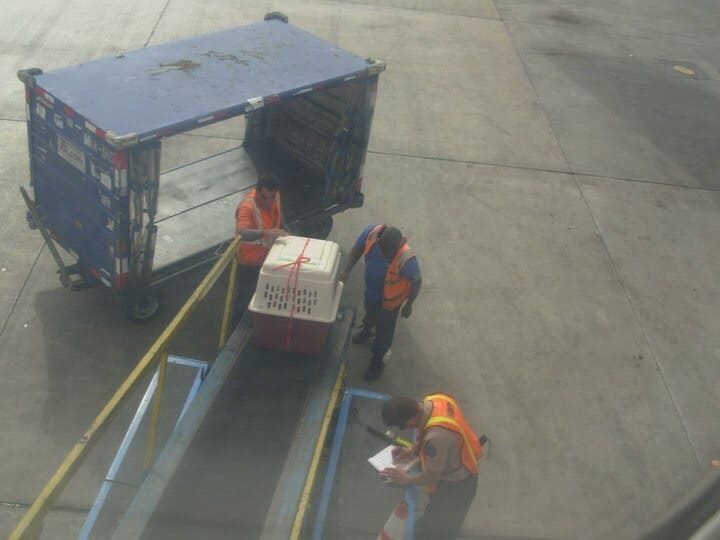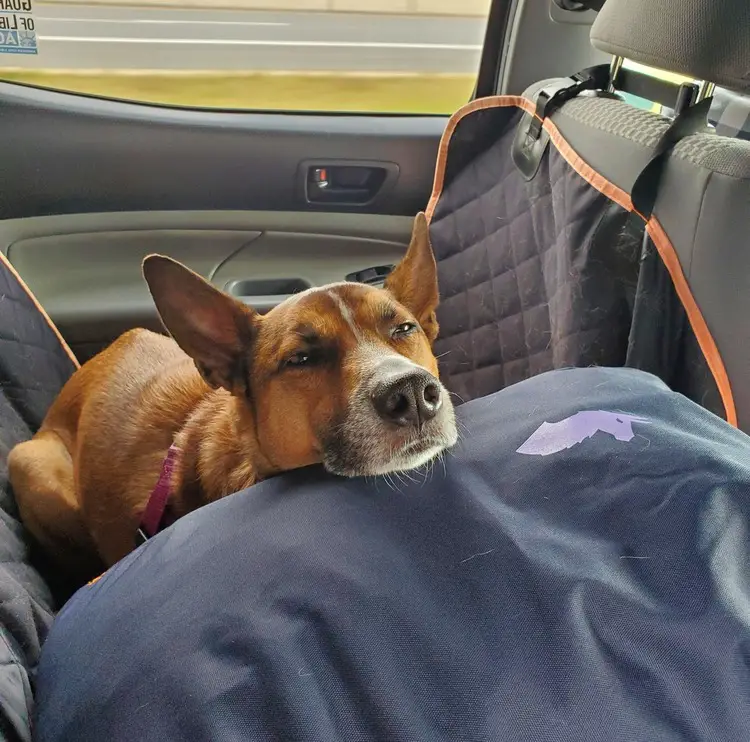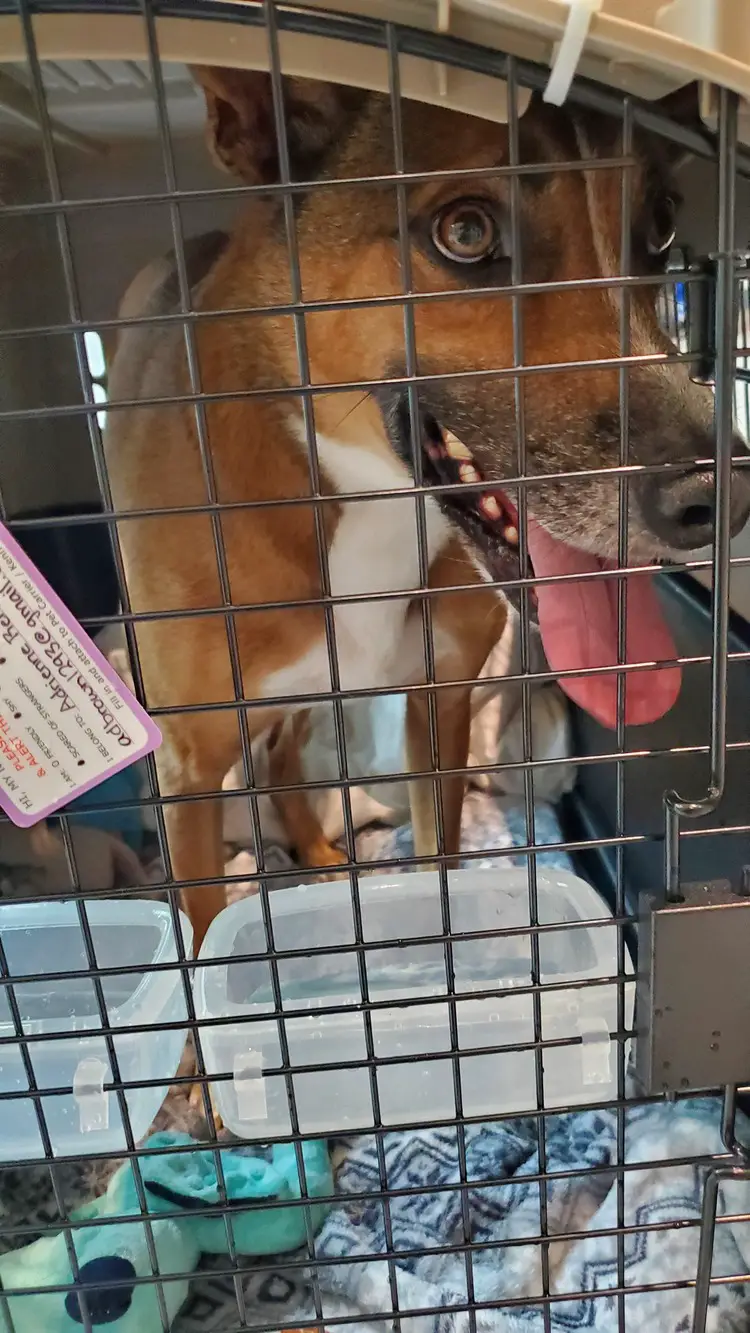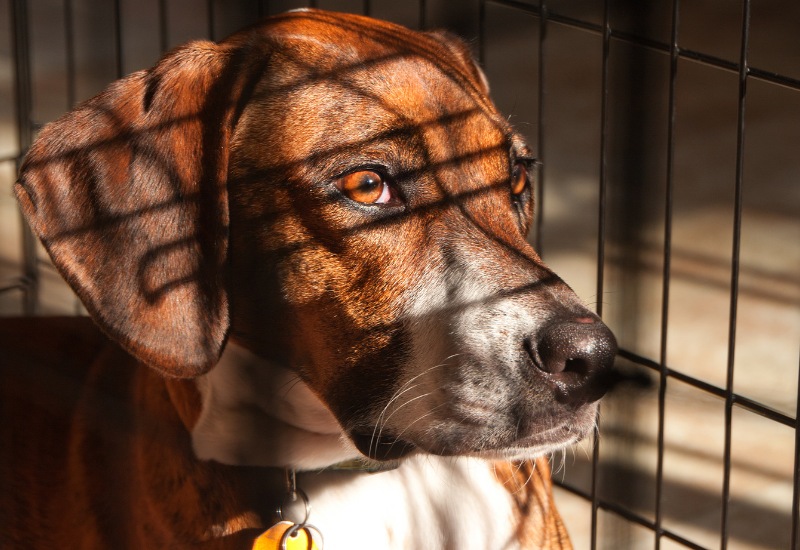In October 2021, I packed up my dog Obi and moved to Germany from North Carolina. Because he is a large dog, he had to travel in cargo while I slummed it in Premium Economy. Sometimes it feels like I studied almost as much for this one flight as I did to earn my wings.
The key to traveling with a dog, or any pet, in cargo, is to do your homework and be prepared.
To this day, I’m not sure who was more stressed in flight, him or me. But either way, we made it.
Table of Contents
How Stressful Is It for a Dog to Fly in Cargo?
Flying in cargo can be an extremely stressful experience for dogs for a number of reasons, including:
- Being away from their human. You cannot fly in cargo with your dog, and since you will be separated upon check-in, your dog will be taken to the aircraft by a total stranger, put into the hold by another stranger, and have to spend the flight without you. This compounds the stress because your presence is likely usually soothing to your dog.
- Unfamiliar environments. The airport, the airplane, and your destination are all unfamiliar environments for your dog which can trigger stress. Most dogs are routine-oriented so throwing new environments at them can cause them to experience stress.
- Noise. Dogs are especially sensitive to noises, and it can be quite loud in the tarmac areas where dogs are kept before being loaded onto the airplane. The cargo holds are also louder than the cabin area, as they tend to be closer to the aircraft’s hydraulic systems.
- The sensation of flying. Dogs cannot understand that the sensations of take-off, turbulence, and landing are normal. They are likely to be further stressed by these strange sensations.
Stressful situations are hard for dogs because they do not necessarily understand that the stress will be temporary.
Is it Cruel to Fly a Dog in Cargo?
No, it is not necessarily cruel to fly a dog in cargo. What is cruel, is giving your dog up simply because you have to move across an ocean.
That said, you should only fly your dog when it is absolutely necessary. So, if you can drive to your destination, do that instead, even if it will take a lot longer.
I also don’t advocate sailing with your dog, because based upon my research, you won’t actually be able to spend time with them on the ship, and they get very few opportunities to stretch their legs while on board.
Since voyages on ocean liners can last for days, it is better to fly, since at least the separation from your fur baby will be shorter, and the stress they experience will be over faster.
Is Flying a Dog in Cargo Safe?

Yes! Of course, there are horror stories out there, but 99% of dogs who fly in cargo arrive safely at their destination.
There are a number of scary myths out there about cargo and how it can negatively impact the health of your dog, but given my proximity to the airline industry, and the sheer amount of research I did before flying to Germany with my own dog, I am happy to report that most of these rumors are false.
So here are a few things to know about how your dog is kept safe while flying in cargo.
- Their crates are secured: Part of the reason airlines have such specific requirements when it comes to the crates they will accept, is because they need to be able to tie the crate in place within the cargo hold. This prevents the crate from being too jostled during turbulence and ensures that Fluffy will arrive without a concussion or a million bruises.
- The cargo area is pressurized: Your pup will be able to breathe as easily as you during the flight since the cargo areas where pets are accommodated is pressurized to the same altitude as the passenger cabin.
- Their crates are checked for hazardous objects: The airline will check inside your crate for any objects that could harm your animal in flight and will advise you to remove anything that you may have put inside that could cause your pet to choke or strangle during the journey.
From one dog parent to another: it is helpful to remember your dog’s behavior will likely be different while flying and they might chew on things, even if they normally wouldn’t. Therefore, it is a good idea to make sure nothing you put in could be chewed into choking hazards or sharp pieces.
Is it Cold for Dogs in Cargo?
Yes, but not as cold as you fear. Let’s be honest it is always cold on planes once they reach cursing altitude. But the cargo area where animals are kept is temperature regulated by the pilots, so they can ensure that your dog is warm enough.
It is allowed to put warm bedding into the crate for your dog to curl up in. When I flew with Obi, he had a fuzzy, fleece-lined crate pad and two fleece blankets in the crate with him to help him stay warm.
You are not allowed to dress your dog in a coat or sweater before crating them for a flight.
How Much Does it Cost to Fly a Dog in Cargo?
To be frank, it is not cheap!
Costs to fly a dog include the cost of buying a crate that meets your airline-of-choice’s specific requirements and specifications, as well as, the cost of the ticket, and any required veterinary documentation that you might need to present for your dog to be granted the right to fly.
To briefly estimate these costs, here is a breakdown of what I paid when moving my dog to Germany:
- Crate: $185
- Crate pad: $25
- Potty pad: $20
- Water and food attachments for crate: $25
- Required health certification form completed by vet: $150
- Required de–worming treatment: $75
- Pet import forms signed by vet: $375
That alone cost me $855! And I hadn’t even purchased his airfare yet!
We flew Lufthansa because we could fly direct. And I will admit, being able to fly direct is worth it, even if it cost a little more money.
Airline Price Comparison for Doggy Cargo Tickets
The cost to fly with a dog in cargo will vary from airline to airline and based upon the size of the dog you are checking.
Smaller dogs cost less; larger dogs cost more.
Beware, the cost is not necessarily based on the weight of your dog, but rather the size of the crate they must be transported in. Because of this, it is a good idea to know what size crate you will need before conducting a price comparison.
For example, Obi was considered a large dog, as far as the airlines were concerned, because he needed a large crate to ensure his ears wouldn’t touch the top of the crate. His are expensive, adorable, priceless ears.
Here are a few airfare estimates to help you get an idea of what it costs to transport a medium/large dog in cargo:
- American Airlines (Charlotte – Seattle): $460
- Lufthansa (US – Germany): $360 + $170 (if transferring in Frankfurt)
- Emirates (All): $650
- JAL (US-Japan): $300
- Etihad (over 6 hours): $250
*Keep in mind all of these prices are for one-way airfare!
Each of these airlines offer a price calculator on their website, so to find out the most accurate information please visit each individual airline’s website and find out what they are charging for pet-in-cargo airfare.
Steps for Flying with Your Dog In Cargo
Now that I have answered your most burning questions, let’s walk through the whole process together, step-by-step so you can get a sense of what you need to do, and when, to get ready to fly with your dog in cargo.
Step 1: Research
You are already on your way! By reading this article you have started the research process. But don’t stop yet, here are things you will need to know before flying with your dog in cargo:
- What time of year is it allowed for you to fly with a dog in cargo between your origination city and your destination? Due to the fact that aircraft climate-controls are less-than-effective on the ground in extremely hot or cold weather, some airlines will not transport animals during seasonal extremes.
- What size crate does your dog need? Bigger is not necessarily better, you want a crate that fits your dog perfectly. Therefore, it is best to take your dog to the pet store and let them “try on” crates to make sure you get the right size.
- What are the crate requirements for your airline? Some airlines require there to be ventilation on all sides of the crate, others don’t. Some airlines require you to have metal screws, others don’t.
- Do you need to have specific paperwork to bring your pet to your destination? This would apply to international travel.
The more you know, the better you will be able to deal with the challenges presented by flying with your dog.
Step 2: Book your flights
The next step is to book your airfare.
Once you have your ticket you will be able to contact the airline and add your pet’s airfare to your reservation.
You must contact the airline before your flight to let them know you will be checking a pet.
This is because they can only transport a certain number of pets per flight.
You usually pay for them at the check-in counter the day of your trip.
Step 3: Take your pet to the vet
Even if your destination does not require you to present a health certificate, it is a good idea to make sure your dog is healthy enough to fly.
It is also a good idea to talk to your vet about your destination, in case there are additional preventative medications that your dog may need prior to traveling to prevent parasites or infections.
Step 4: Prepare your dog’s crate
Make the crate safe and comfortable, and let your dog get used to it before the flight. There are a few things you will need to add to the crate before it’s ready to go, these items include:
- An ID tag: Because your dog may NOT wear its collar during the flight it is recommended that you attach your information to the outside of your dog’s crate. I Zip tied a luggage tag with all Obi’s information on it, to the metal door of his crate.
- A potty pad: Your dog will not be able to leave its crate in-flight to go potty, so an absorbent potty pad must be installed into the crate to prevent messes.
- Food and water dispensers: Most airlines require you to attach a food and water dispenser to the door of the crate that they can fill using a funnel.
- A familiar item: Another way you can help your pet manage their stress during the flight is to include something that smells like you in their crate during the flight. I personally, put an old pillow into the crate with Obi, because it smelled like me, and the home we were leaving behind. Those scents would be familiar and soothing to Obi, amidst the unfamiliar situation.
**It is a good idea to start crate training a month or two before your flight to ensure that your dog is comfortable in their crate.
I recommend getting into a routine of crating your dog for a few hours at a time while you are away from the house, so they get used to the idea of being alone inside their crate.
Step 5: Get ready to go

On the day of your flight make sure you take your dog out for a nice long walk before you head to the airport.
Refrain from feeding your pet right before you fly, you should feed them the night before your trip, and then let them fast until you arrive at your destination. This will help reduce the risk of their tummies getting upset during flight.
Make sure they are able to go potty before you put them into their crate at the airport too.
Dogs do not like to soil their areas, so they will hold it if they have to pee or poo during flight. It’s our job as pet parents to make sure they won’t have to be uncomfortable for the whole flight.
You may give your pet calming treats, or calming water drops prior to flight. Obi was given Rescue Remedy for Dogs before his flight.
It is NOT safe to tranquilize/sedate your dog before flight. This is because it reduces their heart and respiration rates and can increase the risk of seizure, heart attack, and/or other health emergencies in flight.
Step 6: Arrive at the airport
It is good to get to the airport early, but when traveling with a dog you do not want to be too early. It is very helpful to have someone come with you to the airport, so they can take your dog outside to the potty area while you check in at the airline counter.
Once you are checked in, and your dog’s crate has been inspected you will be required to separate from your dog. At this point, you will need to do the following things under the observation of a security officer.
- Put your dog into his crate.
- Remove their collar and tags, nothing can be around your dog’s neck. This is for its safety.
- Tape your information to the outside of their crate.
- Close the crate with zip-ties.
- Say a quick goodbye to your fur baby.
From here your dog will be escorted to the aircraft while you head through security and make your way to the gate.

Step 7: Pick up your baby at your destination
Dogs mostly arrive at the special cargo area of baggage claim, but it is a good idea to ask the customer service agent at your destination where you should go to pick up your dog.
They will be very relieved to see you, I promise.
Step 8: Give your dog a squeeze!
Congratulations, you both survived!
Give your dog a cuddle and spoil them a little for making it through a stressful experience!
Conclusion
Flying with a dog is stressful for both you and your fur baby. Hopefully this post has helped you feel equipped to prepare for and survive a flight with your dog in cargo.
From Adrienne and Obi, we both wish you safe and happy travels!





